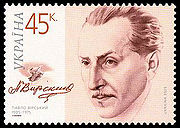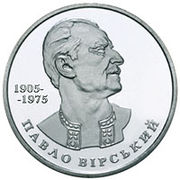
Pavlo Virsky
Encyclopedia

Choreography
Choreography is the art of designing sequences of movements in which motion, form, or both are specified. Choreography may also refer to the design itself, which is sometimes expressed by means of dance notation. The word choreography literally means "dance-writing" from the Greek words "χορεία" ...
, and founder of the P. Virsky Ukrainian National Folk Dance Ensemble
P. Virsky Ukrainian National Folk Dance Ensemble
P. Virsky Ukrainian National Folk Dance Ensemble is a world-renowned Ukrainian dance company based out of Ukraine, well known for its innovative approach to the art form. The ensemble was created in 1937 by Pavlo Virsky and Mykola Bolotov, and guided by Pavlo Virsky until his death in 1975. During...
, whose work in Ukrainian dance
Ukrainian dance
Ukrainian dance refers to the traditional folk dances of the peoples of Ukraine.Today, Ukrainian dance is primarily represented by what ethnographers, folklorists and dance historians refer to as "Ukrainian Folk-Stage Dances" , which are stylized representations of traditional dances and their...
was groundbreaking and influenced generations of dancers.
Early days
Pavlo Virsky was born on February 25, 1905 in OdessaOdessa
Odessa or Odesa is the administrative center of the Odessa Oblast located in southern Ukraine. The city is a major seaport located on the northwest shore of the Black Sea and the fourth largest city in Ukraine with a population of 1,029,000 .The predecessor of Odessa, a small Tatar settlement,...
, at the time part of the Russian Empire
Russian Empire
The Russian Empire was a state that existed from 1721 until the Russian Revolution of 1917. It was the successor to the Tsardom of Russia and the predecessor of the Soviet Union...
(in present-day Ukraine
Ukraine
Ukraine is a country in Eastern Europe. It has an area of 603,628 km², making it the second largest contiguous country on the European continent, after Russia...
). After graduating from the Odessa Music and Drama School in 1927, he continued his studies in Moscow, at the Theater Technicum
Technicum
Technicum was a Soviet institute of vocational education. A mass-education facility of "special middle education" category 1 step higher than PTU, but aimed to train low-level industrial managers or specializing in occupations that require skills more advanced than purely manual...
, from 1927-28.
Beginning in 1925, state theaters began to be organized throughout the Ukrainian SSR
Ukrainian SSR
The Ukrainian Soviet Socialist Republic or in short, the Ukrainian SSR was a sovereign Soviet Socialist state and one of the fifteen constituent republics of the Soviet Union lasting from its inception in 1922 to the breakup in 1991...
, allowing for gainful employment for artists, and upon his return to Odessa in 1928, Virsky joined the Odessa Opera and Ballet Theatre
Odessa Opera Theater
The Odessa National Academic Theater of Opera and Ballet is the oldest theater in Odessa, Ukraine. The Theater and the Potemkin Stairs are the most famous edifices in Odessa....
as a dancer and choreographer. It was at this theater that he collaborated with Mykola Bolotov in their first joint production: Gliere
Reinhold Glière
Reinhold Moritzevich Glière was a Russian and Soviet composer of German–Polish descent.- Biography :Glière was born in Kiev, Ukraine...
's The Red Poppy
The Red Poppy
The Red Poppy or sometimes The Red Flower is a ballet in three acts and an apotheosis; score written by Reinhold Glière and a scenario by Mikhail Kurilko. This ballet was created in 1927 as the first Soviet ballet with a modern revolutionary theme....
. Virsky left the Odessa in 1931, and worked as a balletmaster at various theatres, including those in Kharkiv
Kharkiv
Kharkiv or Kharkov is the second-largest city in Ukraine.The city was founded in 1654 and was a major centre of Ukrainian culture in the Russian Empire. Kharkiv became the first city in Ukraine where the Ukrainian Soviet Socialist Republic was proclaimed in December 1917 and Soviet government was...
, Dnipropetrovsk
Dnipropetrovsk
Dnipropetrovsk or Dnepropetrovsk formerly Yekaterinoslav is Ukraine's third largest city with one million inhabitants. It is located southeast of Ukraine's capital Kiev on the Dnieper River, in the south-central region of the country...
, and Kiev
Kiev
Kiev or Kyiv is the capital and the largest city of Ukraine, located in the north central part of the country on the Dnieper River. The population as of the 2001 census was 2,611,300. However, higher numbers have been cited in the press....
, working on productions of ballets such as Raymonda
Raymonda
Raymonda is a ballet in three acts, four scenes with an apotheosis, choreographed by Marius Petipa, with music by Alexander Glazunov, his opus 57. First presented by the Imperial Ballet at the Imperial Mariinsky Theatre on in St. Petersburg, Russia...
, La Esmeralda
La Esmeralda (ballet)
La Esmeralda is a ballet in 3 acts, 5 scenes, inspired by Notre Dame de Paris by Victor Hugo, originally choreographed by Jules Perrot; with music by Cesare Pugni and design by William Grieve , D. Sloman , Mme...
, Le Corsaire
Le Corsaire
Le Corsaire is a ballet typically presented in three acts, with a libretto originally created by Jules-Henri Vernoy de Saint-Georges loosely based on the poem The Corsair by Lord Byron. Originally choreographed by Joseph Mazilier to the music of Adolphe Adam, it was first presented by the ballet of...
, Swan Lake
Swan Lake
Swan Lake ballet, op. 20, by Pyotr Tchaikovsky, composed 1875–1876. The scenario, initially in four acts, was fashioned from Russian folk tales and tells the story of Odette, a princess turned into a swan by an evil sorcerer's curse. The choreographer of the original production was Julius Reisinger...
, and Don Quixote
Don Quixote (ballet)
Don Quixote is a ballet originally staged in four acts and eight scenes, based on an episode taken from the famous novel Don Quixote de la Mancha by Miguel de Cervantes. It was originally choreographed by Marius Petipa to the music of Ludwig Minkus and was first presented by the Ballet of the...
.
Folk dance

Kiev Opera
The Kiev Opera group was formally established in the summer of 1867, and is the third oldest in Ukraine, after Odessa Opera and Lviv Opera. Today, the Kiev Opera Company performs at the National Opera House of Ukraine named after Taras Shevchenko in Kiev....
brought two productions to Moscow in 1936 as part of the first festival of Ukrainian Literature and Art: Mykola Lysenko
Mykola Lysenko
Mykola Vitaliiovych Lysenko was a Ukrainian composer, pianist, conductor and ethnomusicologist.- Biography :Lysenko was born in Hrynky, Kremenchuk Povit, Poltava Governorate, the son of Vitaliy Romanovich Lysenko . From childhood he became very interested in the folksongs of Ukrainian peasants and...
's opera Natalka Poltavka
Natalka Poltavka (opera)
Natalka Poltavka is an opera in three acts by the Ukrainian composer Mykola Lysenko, based on the play Natalka Poltavka by Ivan Kotlyarevsky, first performed in 1889.-Background:...
, and Semen Hulak-Artemovsky
Semen Hulak-Artemovsky
Semen Stepanovych Hulak-Artemovsky , was a Ukrainian opera composer, singer , actor, and dramatist who lived and worked in Imperial Russia....
's opera Zaporozhets za Dunayem
Zaporozhets za Dunayem
Zaporozhets za Dunayem Beyond the Danube, also referred to as Cossacks in Exile) is a Ukrainian comic opera with spoken dialogue in three acts with music and libretto by the composer Semen Hulak-Artemovsky . The orchestration has subsequently been rewritten by composers such as Reinhold Glière and...
(A Zaporizhian [Kozak] Beyond the Danube), the latter which included choreographed Ukrainian folk dances by Pavlo Virsky and Mykola Bolotov. The following year, Virsky and Bolotov founded the State Folk Dance Ensemble of the Ukrainian SSR
P. Virsky Ukrainian National Folk Dance Ensemble
P. Virsky Ukrainian National Folk Dance Ensemble is a world-renowned Ukrainian dance company based out of Ukraine, well known for its innovative approach to the art form. The ensemble was created in 1937 by Pavlo Virsky and Mykola Bolotov, and guided by Pavlo Virsky until his death in 1975. During...
, with which they developed an entire program of staged Ukrainian folk dances.
With the outbreak World War II, and in the build-up to the Great Patriotic War, many ensembles suspended activity, as performers were enlisted to entertain the troops. Virsky continued his work with folk-themed choreography as the director of the Red Flag Song and Dance Ensemble of the Kiev Military District beginning in 1939. In 1942, he left as that ensemble, and became the artistic director of the Red Army Song and Dance Ensemble
Red Army Choir
The A.V. Alexandrov Russian army twice red-bannered academic song and dance ensemble , in short, the Alexandrov ensemble is a performing ensemble that serves as the official army choir of the Russian armed forces...
dancers, and remained in that post for many years.

Virsky died on July 5, 1975 in Kiev. The State Folk Dance Ensemble of the Ukrainian SSR was named after him in 1977.

